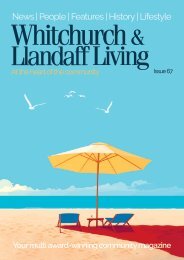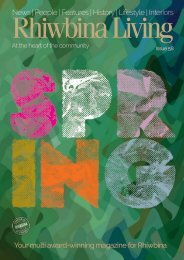You also want an ePaper? Increase the reach of your titles
YUMPU automatically turns print PDFs into web optimized ePapers that Google loves.
ship's lifeboats were changed from<br />
blue to white; and crucially, the<br />
ship was renamed Bantam, taking<br />
the name of another ship of similar<br />
tonnage on the Lloyd's Register.<br />
Shipping documentation was<br />
forged to support the false name.<br />
Any identifying objects on the ship<br />
were either thrown overboard or<br />
used as fuel in the ship's coal-fired<br />
engines.<br />
He made<br />
it clear that<br />
anyone who did<br />
not cooperate<br />
with the plan<br />
would be shot<br />
on the spot<br />
The crew were instructed to<br />
say that the ship had sailed<br />
from Singapore if questioned by<br />
authorities. The ship next sailed to<br />
the Cape Verde Islands and then to<br />
Santos, Brazil, where it arrived on<br />
Boxing Day 1880.<br />
The crew took on a consignment<br />
cargo of coffee destined for<br />
Marseilles. Henderson then sailed<br />
for Cape Town, where Watkins<br />
disembarked, changing the ship's<br />
name for the second time en route,<br />
this time to the name India. On<br />
arrival at Cape Town, he sold the<br />
coffee for £13,000. He then sailed<br />
for Port Phillip in Victoria, Australia<br />
via Mauritius and Albany, Western<br />
Australia arriving at Victoria in April<br />
1881. Henderson told Australian port<br />
authorities that he had come from<br />
Bermuda.<br />
Back in Scotland, the ship's<br />
owners were becoming<br />
increasingly concerned about the<br />
disappearance of the ship. They<br />
advertised the disappearance, and<br />
sought help locating it.<br />
By chance, an observant wharf<br />
policeman on duty at Queenscliff,<br />
Constable James Davidson, who<br />
had recently arrived from Scotland,<br />
was at his post as the newly-named<br />
India steamed past him.<br />
At the time, he happened to be<br />
reading a copy of The Scotsman<br />
newspaper which included an<br />
article taken from the Glasgow<br />
Evening Citizen and which described<br />
the mysterious disappearance of<br />
the Ferret from the Clyde.<br />
Seeing that the India fitted the<br />
description well, Davidson decided<br />
to take a closer look. He noticed<br />
certain unusual behaviours coming<br />
from the ship, and noted that<br />
it had broken a number of port<br />
regulations.<br />
His suspicions raised, he kept it<br />
under observation and alerted his<br />
superiors. Customs officials seized<br />
the ship, and the faint appearance<br />
of another vessel's name under the<br />
lettering 'India' soon confirmed the<br />
hoax.<br />
Henderson and his accomplices<br />
tried to escape but were soon<br />
apprehended, charged, and<br />
brought to trial by jury in Melbourne<br />
before Justice Williams. Henderson,<br />
and his two main cronies were each<br />
charged with conspiracy on the<br />
high seas, attempt to defraud the<br />
ship's owners, and customs and<br />
other maritime offences, including<br />
changing the name and official<br />
number of a ship. Chief Engineer<br />
Griffin, who had been recruited in<br />
Glasgow, provided much of the<br />
evidence that convicted the three.<br />
Watkins, the Sailing Master, had<br />
left the ship in Cape Town after<br />
which a sailor called Wright had<br />
taken over the sailing duties. The<br />
three defendants fabricated a story<br />
that Watkins had led a Peruvian<br />
arms smuggling racket, and that<br />
he told them to attempt to sell the<br />
ship. The court rejected the story<br />
and found the three men guilty.<br />
But that's not where the story<br />
ends. A long time later, a letter<br />
landed on the desk of Cardiff's<br />
Head Constable. The letter,<br />
apparently written by a prisoner in<br />
Spain, requested the help to find<br />
treasure 'of considerable amount'<br />
that had been buried in Cardiff.<br />
The Head Constable dismissed the<br />
letter as a hoax. The letter was also<br />
shown to a borough magistrate,<br />
who came to a different conclusion.<br />
Correspondence with the<br />
prisoners was initiated, and before<br />
long, the prisoner admitted that<br />
he was at one time the private<br />
secretary of a Spanish nobleman<br />
who entrusted him with property<br />
to a considerable amount to be<br />
conveyed to England. He came<br />
to London with it, but from the<br />
start, he evidently intended to<br />
appropriate the property to his own<br />
use. He left London, went to Bristol,<br />
and stayed for some time at a hotel<br />
there. He then came to Cardiff and<br />
stayed for a still longer period at the<br />
Cardiff Arms Hotel.<br />
During his stay there, his friends<br />
in Madrid informed him that his<br />
employer had discovered his<br />
duplicity, and agents were sent<br />
to England to arrest him. Fearing<br />
SS Ferret in 1910<br />
history<br />
capture, he deposited the valuable<br />
treasure that he had been entrusted<br />
with in a secret place, not far from<br />
Cardiff, and then left in a steamer<br />
bound for Marseilles, but was<br />
landed on the coast of Spain. He<br />
was discovered by the agents of the<br />
nobleman, arrested, and tried at<br />
Madrid for feloniously disposing of<br />
property entrusted to him by his<br />
master, and sentenced to a long<br />
term of imprisonment in one of the<br />
carceras in Madrid.<br />
It was noted during the months<br />
that followed, that three men were<br />
spotted digging in various parts of<br />
a wood in the north of Cardiff. The<br />
men could not speak English well<br />
and were said to be of Spanish<br />
extraction. It is believed nothing was<br />
found at that time.<br />
As for the Ferret, in 1904, it was<br />
called into action to assist with a<br />
stricken Norwegian barque that<br />
went under the name of Ethel.<br />
The Ethel had run onto a South<br />
Australian beach and the Ferret was<br />
the first ship on hand to rescue its<br />
crew and passengers. The beach<br />
was later named Ethel Beach.<br />
As fate would have it, the Ferret<br />
itself was wrecked too in November<br />
1920 after running onto a beach<br />
during a storm. All 21 crew were<br />
rescued after walking 3 miles<br />
overland from where the ship had<br />
foundered - on Ethel Beach.<br />
The treasure, if it exists, has never<br />
been found.<br />
The mystery of the treasure has<br />
been written into a ghost story<br />
centred on Cardiff, by <strong>Rhiwbina</strong><br />
author, John F Wake, entitled<br />
‘The Madding of Eli McNamara’.<br />
35

















